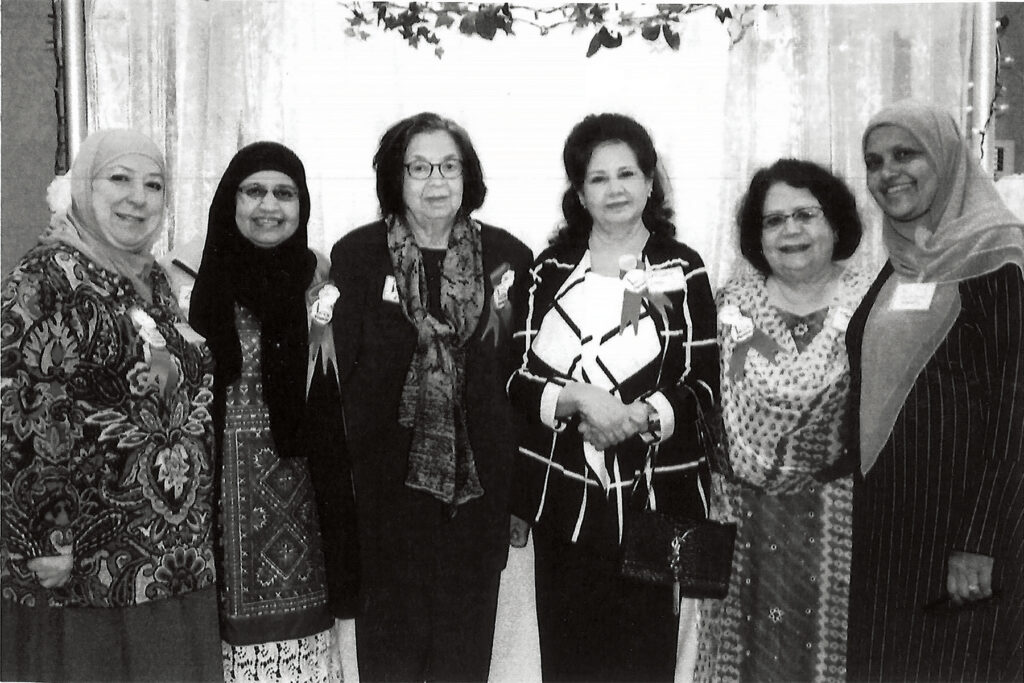From Very Humble Roots Where Muslim Communities Began, Survived, and Thrived
By Ferial Abraham
Sept/Oct 2023

As a founding MSA member since 1963, my interest has always been in its growth.
In Minneapolis-St. Paul, the mother of these communities was the University of Minnesota’s MSA chapter that met for Friday Quranic Study. Prayers, discussions, and planning occurred in Room 325 at the Coffman Union. Although the group was composed of both Muslim men and women, and some friends, a doctoral female student emerged as leader.
To establish their legacy, they collected donations for a future mosque. This money was later used to help fund the Islamic Center of Minnesota in 1970. They also transferred many of their social events to the ICM including the tradition of the annual Ramadan Dinner.
In 1967, Minnesota Muslims took another step forward. That’s when a Muslim man registered with the State to be able to solemnize Muslim marriages in accordance with state laws allowing an Islamic legal ceremony. His responsibility included signing the State Marriage License and sending it to their local courthouse for recording. The courthouse would return a copy to the married couple.
My early experiences at the University of Minnesota Minneapolis-Saint Paul Campuses were unique. At that time there were no mosques in Minnesota. Today there are 92. I met MSA members at the Prophet’s (salla Allahu ‘alayhi wa sallam)) birthday celebration. I was a graduate student in summer sessions — the only way I could afford graduate school.
The Friday evening Qur’an Study would meet at 7:30 p.m. Our group consisted of about 10 sisters and brothers and sometimes friends. We were the only Muslims we knew on campus. I lived at Bailey Hall on the Saint Paul Campus and would ride the intercampus bus to about three blocks from Coffman Union.
It was a very warm evening in July when I walked to the intercampus bus stop after Qur’an Study. When no bus arrived, I started walking in the direction the bus would travel. It was very dark and I continued to walk from the Minneapolis Campus to the Saint Paul Campus. Years later, I clocked my walking path and it was almost four miles. These were the days when businesses closed early, there were no public phones that I could see, and really no other help. I arrived at my dormitory before midnight.
In 1968, my mother and I moved to Saint Paul. It was the days of competitive graduate schools and less money. I became a U of MN teaching assistant and completed my Master of Arts degree. In the Fall, I began teaching at a local high school. At a winter graduation, Dr. Iffat Shah (from MSA) and I received our degrees. The MSA students and friends had a graduation party for us at what they called the Muslim House, a rental home, in Saint Paul. My guests were my mother and my aunt from Dearborn, Mich.
In 1970, the MSA continued to meet at Coffman Union, having such activities as Welcome Parties for new students, celebration of the Prophet’s birthday, and Friday Prayers. Coffman Union is still the MSA meeting place today. There were also picnics at parks during the summer. The members truly enjoyed these events, and we would reach out to non-Muslims too.
The year 1970 was also a transition year for the community. The members were getting older and they wanted to expand to a non-university organization. The MSA would continue at the University of Minnesota. The new organization became the Islamic Center of Minnesota with articles of incorporation recorded in the office of Secretary of State (Minn.) on December 2, 1970.
Donated funds were used as a down payment for a large rooming house and first floor meeting rooms, near the U of Minnesota campus calling it the Dinkytown ICM. ICM’s general activities in the years to come were celebration of Eid al Fitr, Eid Al Adha, Islamic New Year, Ashura, the Prophet’s birthday, Ramadan Dinner, ICM picnics, ICM Newsletter and publications, and an Islamic Sunday School for children. In 1973, the Women’s Islamic Society began their activities. They had a board of directors and several officers. Rafaat Hager was appointed as the first ICM imam.
In 1975, the location of the ICM changed. The Abukhadra family, originally from Saudi Arabia, gifted a building in Columbia Heights, Minn. This building was headquarters for several years and provided a first-floor prayer area. It is called the Abu Khadra Mosque.
In addition to the Dinkytown ICM, the Abukhadra Mosque, a new building called the Islamic Center of Minnesota in Fridley, Minn. was added in 1984 from membership contributions. In a few years, an Islamic Day School was added for grades K-10 on the adjacent land and connected to the Center — the Al Amal School with academic excellence.
What followed in the next years was the purchase of land for several Islamic cemeteries and body washing rooms in some mosques. Many additional activities are available at the Fridley ICM. These include discussion groups for sisters (in a donated house next door to the Center), free medical clinic on Sundays, larger Saturday and Sunday Schools for children, Interfaith Dialogue Groups, and Youth activities to name a few. Lunch was served on Sunday and dinners and bazaars continued. The ICM provided vital support for its members and neighbors.
The Women’s Islamic Society is a very helpful support group for Muslim women. Not only did they find friends, but also worked together on projects promoting Islam. The group provided yearly dinners mostly at the International Institute of Minnesota during the mid 1970s through the 1980s to the public by reservations only. They would feature a predominantly Muslim country, its food, its cultural presentation and entertainment. They included a bazaar selling homemade items and cookbooks published by the ICM.
As membership increased, many families moved to other locations in the area. They saw the need for mosques and centers in their localities as many new immigrants arrived in Minnesota. The newer arrivals were from Afghanistan, Somalia, Bosnia, Somali, Burma, Sudan, Iraq, Syria, Iran, and other countries. Not only more mosques and centers were established but also restaurants, stores, retailers, and auto businesses. In Minnesota, Muslims can be found in many fields including government, health, education, and law.
The Metropolitan area mosques and centers are in the cities of Minneapolis, Saint Paul, Blaine, Bloomington, Brooklyn Park, Brooklyn Center, Burnsville, Columbia Heights, Fridley, Plymouth, Maple Grove, Maplewood, Eden Prairie, Woodbury, and others. The mosques and centers are on all four sides of this area as are the Islamic cemeteries. I recently found the gravesite of a distant Muslim relative, Mike (Muhammed) Abas at the historic Oakland Cemetery in Saint Paul, who died in November 1925.
More recent activities of the ICM were a party for the ICM founders in 2019, almost 50 years after its founding. Three years ago, ICM president Zaheer Baber established and hosted Khatera, Friday ICM Noon Lecture by Imams on Zoom.
Several of our community members were educated and taught at the University of Minnesota and Minnesota State Universities and Colleges and have made substantial contributions to North America and around the world. We truly miss the Ghazi family, Tasneema and the late Abidullah, who established IQRA International Education Foundation in Chicago.
Fast forward to 2023, the Muslim communities here are more different. There are more than 90 diverse mosques and centers. There are many graduate programs and affluent students. Many colleges and universities have their own MSA Chapters. Fifty-six years ago in 1967, we were the core members who established many flourishing Muslim communities with Allah’s help. We are immensely grateful.
Ferial Abraham was born in North Dakota in 1939 and an only child. Her parents had immigrated to the U.S. with their parents when they were children. Her parents are listed Syrian but later that part of Syria became Lebanon. She taught high school for 39 years, 31 of which at a large suburban Saint Paul high school. She has always been active in Islamic organizations.
Tell us what you thought by joining our Facebook community. You can also send comments and story pitches to horizons@isna.net. Islamic Horizons does not publish unsolicited material.
